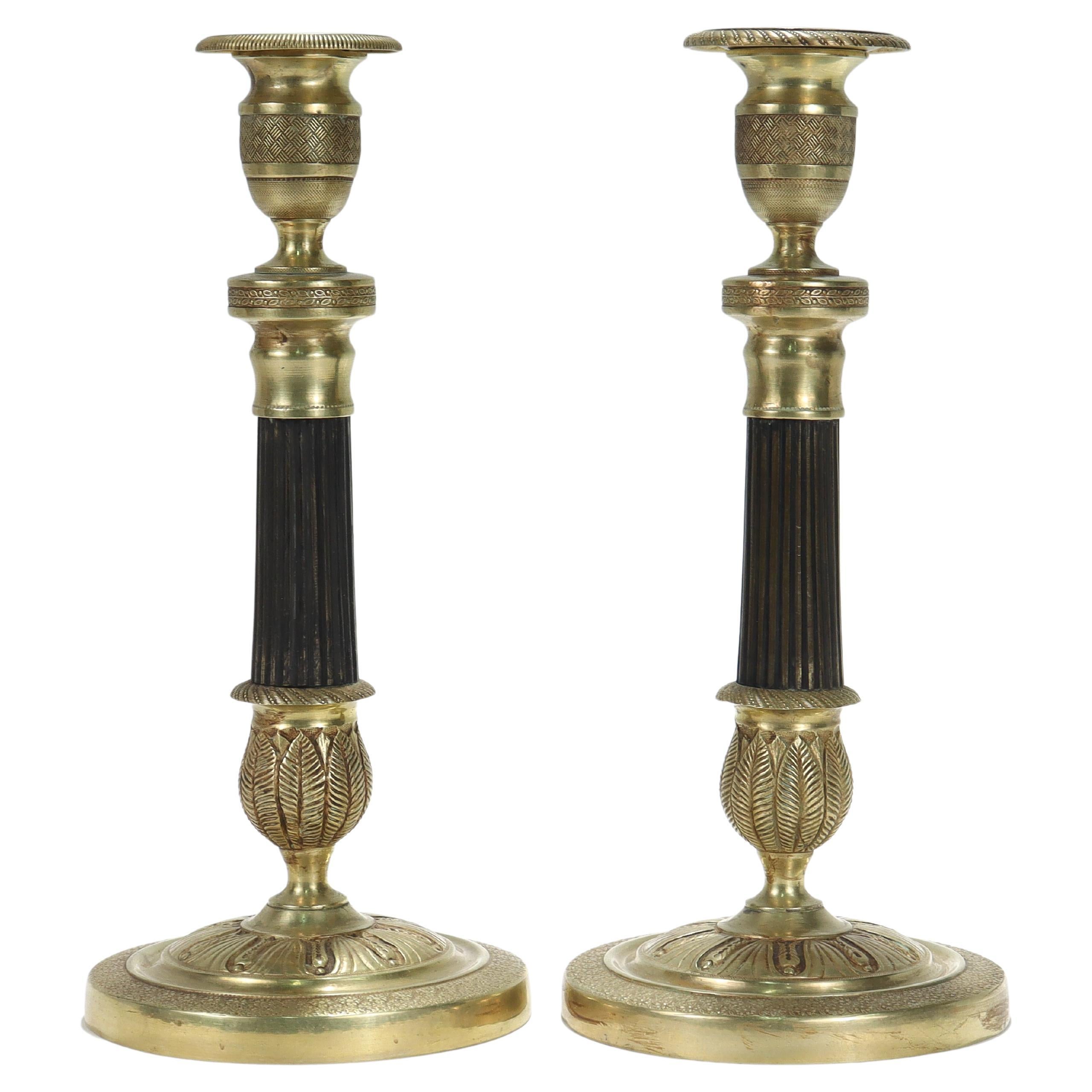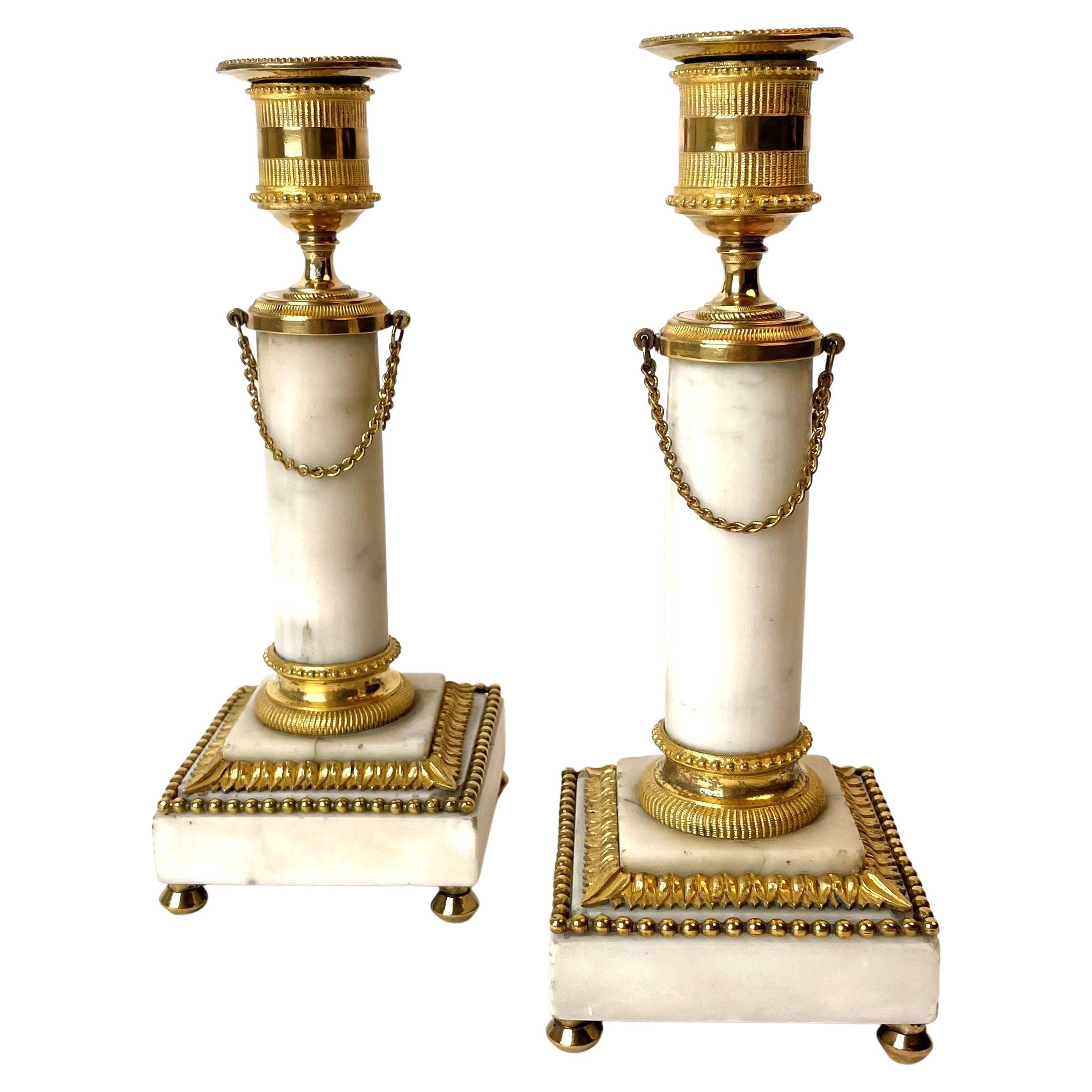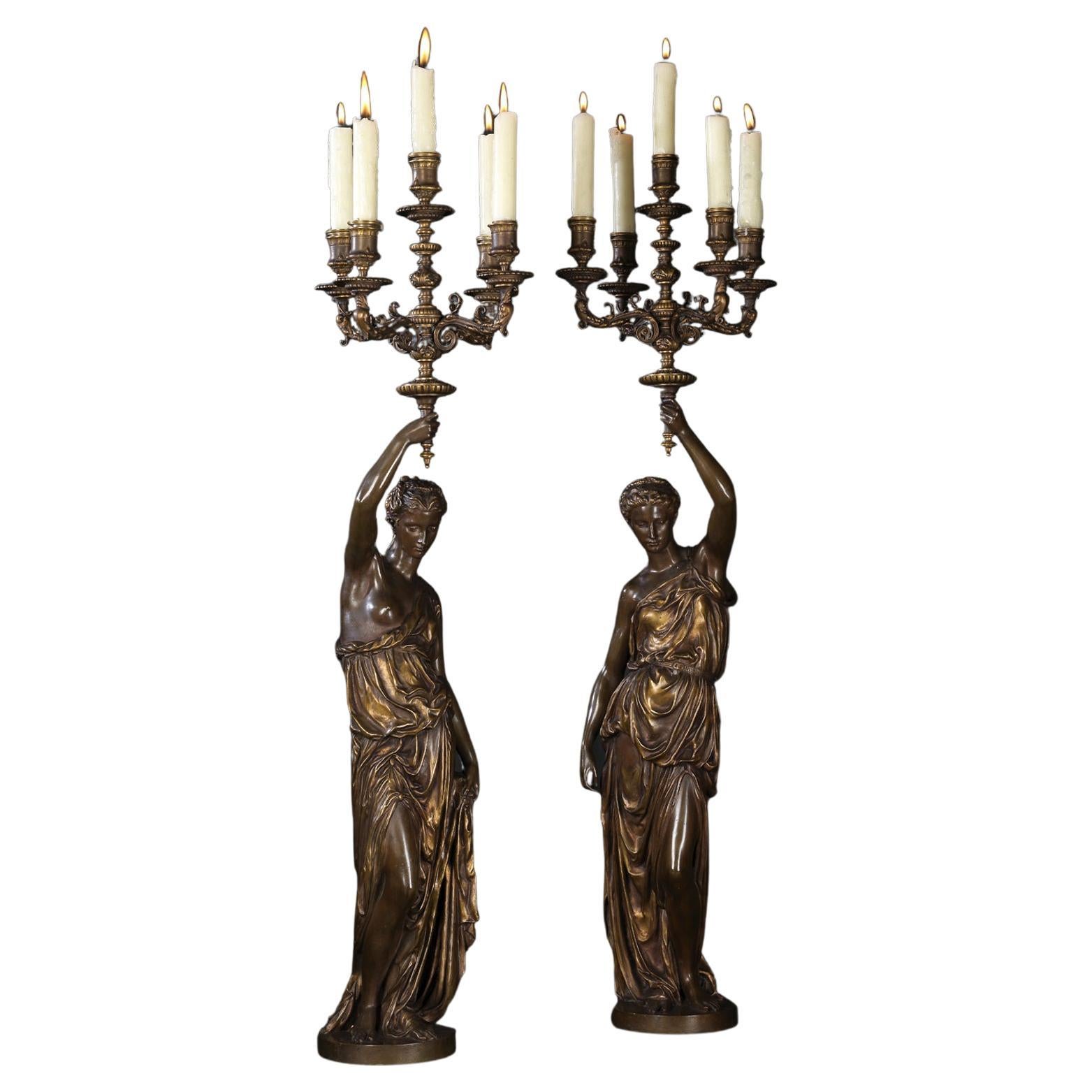Items Similar to F.Barbedienne a Gilt Bronze and Cloisonné Enamel Candlestick
Want more images or videos?
Request additional images or videos from the seller
1 of 14
F.Barbedienne a Gilt Bronze and Cloisonné Enamel Candlestick
About the Item
Ferdinand Barbedienne (1810-1892)
A very fine gilt bronze and great quality polychrome cloisonné enamel hand
candlestick.
Signed F.BARBEDIENNE
Circa 1875.
- Creator:Ferdinand Barbedienne (Maker)
- Dimensions:Height: 3.55 in (9 cm)Width: 6.3 in (16 cm)Depth: 5.91 in (15 cm)
- Style:Napoleon III (Of the Period)
- Materials and Techniques:
- Place of Origin:
- Period:
- Date of Manufacture:circa 1875
- Condition:
- Seller Location:Saint-Ouen, FR
- Reference Number:1stDibs: LU2612325849052
About the Seller
4.9
Vetted Seller
These experienced sellers undergo a comprehensive evaluation by our team of in-house experts.
1stDibs seller since 2017
56 sales on 1stDibs
Typical response time: 1 hour
- ShippingRetrieving quote...Ships From: Saint-Ouen, France
- Return PolicyA return for this item may be initiated within 2 days of delivery.
More From This SellerView All
- A Very Fine Quality 19th Century French Pair of CandlesticksLocated in Saint-Ouen, FRVery Fine French 19th Century Pair of Candlesticks In ormolu, very finely chiseled and decorated with knotted garlands, branches of leafy flowers, spokes of hearts, leaves of water...Category
Antique 1870s French Louis XVI Candlesticks
MaterialsOrmolu
- A French ‘Chariot’ Three-pieces Clock Garniture attributed to F.Linke circa 1890By François LinkeLocated in Saint-Ouen, FRA French Ormolu and Patinated-Bronze ‘Chariot’ Three-pieces Clock Garniture Attributed to François Linke (1855 - 1946), Paris, Late 19th/ Century The clock representing a putto on ...Category
Antique 1890s French Napoleon III Mantel Clocks
MaterialsBronze, Ormolu, Enamel
- Diana the Huntress, 19th Century French Enamel TazzaBy Théophile SoyerLocated in Saint-Ouen, FRDiana The Huntress A 19th century French Enamel Tazza Tazza with scalloped edges in polychrome enamel, painted on copper with red background and gold highlights representing Diana the Huntress painted partly in grisaille; translucent and red counter-enamel. Paris, Théophile Soyer (1853-1940) circa 1880 Théophile Soyer (23 July 1853-20 February 1940) His father, Paul Soyer, gold medalist in 1878, created after the 1870 war the famous work-shop at 4 bis, rue Saint-Sauveur in Paris, which produced innumerable pieces, including some for jewellery, furniture and bronze. Théophile took classes with Yvon and Levasseur and made his debut at the 1870 Salon with an enamel copy of a work by Le Barbier aîné. He then exhibited regularly from 1875 to 1882. After his marriage in 1879 to Léa, née Dejoux, nicknamed Lucie, a pupil of Lamunière, he shared the management of the firm with her, just as he shared the gallery in her company at certain exhibitions. He won a silver medal at the Universal Exhibition of 1889, then a gold medal at the one in 1900. He was president of the Société des éclectiques, a humorous society founded in 1872, and vice-president of the Chambre de la céramique et du verre de l'Union. Founded in Paris during the Second Empire, the workshop directed by Paul Soyer (1832-1903) and then his son Théophile (1853-1940) produced various objects, paintings, mirrors, trays, vases, bonbonnières. Based on new sources of information, an article in l’Objet d’Art magazine, publications Faton, presents an update of the Soyer biographical elements and an analysis of their production marked by the neo-Renaissance and then Art Nouveau. A book of accounts allows us to observe the models of enamel "paintings", often from Meissonier’s work. The Soyers have greatly contributed to satisfying the taste of painted enamels that grew from the 1860s to the 1900 exhibition...Category
Antique 1880s French Napoleon III Decorative Dishes and Vide-Poche
MaterialsCopper, Enamel
- 19th Century Pair of Neo Greek Sellettes en AthéniennesBy Ferdinand BarbedienneLocated in Saint-Ouen, FRA French 19th century very unusual and decorative pair of neo greek gilt and patinated cast iron sellettes en athéniennes With red griotte marble bassin...Category
Antique 1870s French Greek Revival Pedestals
MaterialsGriotte Marble, Metal, Ormolu
- French 19th Century Pair of Lacquered Bamboos Japonisme VasesBy Ferdinand Barbedienne, Edouard LievreLocated in Saint-Ouen, FRA 19th French century pair of Lacquered Bamboos Japonisme vases. An amazing pair of tall cylindrical bamboo vases decorated in Japanese Gold and Sil-ver Hiramaki-E Lacquer with Pavilions in The Mist and Weaving Figures, Flown Over by a Pair of Cranes. Enclosed in a Sino-Japanese Inspiration Golden and Brown Patina Bronze Mount Featuring Elephant Heads, Partially Openwork Branches and Salamanders Forming Side Handles. Circa 1870 Attributed to Édouard Lièvre (1828-1886) and Ferdinand Barbedienne (1810-1892) Édouard Lièvre (1828-1886) is one of the most talented and prolific designer and industrialist of the 19th Century, his repertoire is sometimes Sino-Japanese or Neo-Renaissance, whether in furniture or works of art, we can note in particular the parade bed of Valtesse de La Bigne, furniture commissioned by the painter Édouard Detaille or even Sarah Bernhardt, and the famous works in collaboration with Maison Christofle or those in gilded bronze and cloisonné enamel edited by Ferdinand Barbedienne, presented at the Universal Exhibitions in 1878, 1889 and 1900. He was both a draftsman, painter, illustrator, engraver, ornamentalist and cabinetmaker, first trained in the studio of the painter Thomas Couture, Lièvre was then fully immersed in the world of decoration, creation and ornamentation and provides designs for manufacturers and merchant-publishers. Often assisted by his brother Justin, he first produced works of art for his own apartment, seeking out the finest craftsmen to execute his designs for bronzes, ceramics, fabrics and luxury furniture from great virtuosity and great taste. He then collaborated with the cabinet-maker Paul Sormani, as well as haberdasher merchants such as the Escalier de Cristal, bronziers such as Maison Marnyhac and especially Ferdinand Barbedienne as on our vases with bronze mounts characteristics of Edouard Lièvre's work. Born in 1810, died in Paris in 1892, Ferdinand Barbedienne, the most important caster of bronze pieces of art during the second half of the 19th Century, created and directed in Par-is one of the major artistic foundries of his time. Barbedienne specialized in classical reproductions, whose models were exposed in famous European museums. Their illustrated catalogues included many diverse objects such as busts, ornemental sculpture (clocks, candelabras, cups) sometimes even life-sized and bronzes for furniture. Apart from his own produc-tion, Barbedienne worked for the most renowned sculptors such as Barrias, Clésinger and Carrier-Belleuse. All his works were highly esteemed and he, himself honored by contemporary critics. At the London exhibition in 1851 Barbedienne’s firm won two « Council medals ». At the 1855 Universal Exhibition, he won a medal of honor. The success of Barbedienne’s firm brought him many official commissions, such in about 1860, as Barbedienne supplied bronzes for furniture for the Pompeian Villa of Prince Napoléon-Joseph, located avenue Montaigne in Paris. At the London Universal Exhibition of 1862 Barbedienne won medals in three different categories: Furniture, Silversmith work and Artistic bronzes. Barbedienne was made an officer of the Légion d’Honneur in 1867 and Commander in 1878 when he was compared with « a prince of industry and the king of bronze casting ». His glory did not decline with the passage of the time for at the Universal Exhibition of 1889 the critics thanked Barbedienne for the example he set for other bronze-casters by the perfection of his bronzes. “Japonisme” in the second half of the 19th century, was a craze for everything that came from Japan or imitated its style. The word was first coined in a series of articles published by Philippe Burty, from May 1872 to February 1873, in the French magazine “la Renaissance Littéraire et Artistique”. Far from the Academic sphere, artists seeking for new ways of expression, appropriated this discovery. Manet and the impressionists led the way to half a century of enthusiasm for Japanese art, and largely contributed to the esthetical revolution Europe experienced between 1860 and the beginning of the twentieth century. From 1862, The World’s Fairs provoked massive arrivals of fans, kimonos, lacquers, bronzes, silks, prints and books that launched the real era of Japonisme. With those exhibitions, the demand was boosted, the number of merchants and collectors was multiplied, and artists became passionate about this new esthetic. For them, its “primitivism” was probably its most important quality: artists were fond of the Japanese art’s capacity to be close to nature and to reconcile art and society by representing, with a lot of care, the most trivial objects. In painting, Edouard Manet, Mary Cassatt, Degas, Van Gogh, Gauguin were among those who were deeply inspired by Japanese art, affected by the lack of perspective and shadow, the flat areas of strong color, the compositional freedom in placing the subject off-center, with mostly low diagonal axes to the background. The Japanese iris, peonies, bamboos, kimonos, calligraphy, fish, butterflies and other insects, the blackbirds, cranes and wading birds, the cats, tigers, and dragons were endless sources of inspiration, appropriation, and reinterpretation for European artists. The occidental productions were combining styles and artistic conceptions instead of copying Japanese art slavishly. That is what brings to light the comparison between the artworks of Kitagawa Utamaro and Degas, of Katsushika Hokusai and Van Gogh The World’s Fairs of 1851 and 1862 in London, those of 1867, 1878, 1889 and 1900 in Paris, of 1873 in Vienna and of 1904 in Saint Louis presented a number of “Japanese-Chinese” installations with earthenware, bronzes, screens and paintings and attracted the largest amounts of visitors In Vienna, the “Japanese village...Category
Antique 1870s French Japonisme Vases
MaterialsBronze
- Impressive French 19th Century Neo-Greek Style Bronze Nine-Lights CenterpieceBy Georges Emile Henri ServantLocated in Saint-Ouen, FRAn impressive French 19th century Neo-Greek style bronze nine-lights center piece In patinated and gilt bronze, engraved on the body of foliage and rings, the collar decorated with a frieze of palms in bas-relief. It is held by a tripod base decorated with shards, foliage, and fins, in the center a mask of man. Surmounted by three arms, nine-lights ending in lion’s paw. Curved triangular base with ivy friezes, and palm-leaf feet. Attributed to Georges Emile Henri...Category
Antique 1860s French Napoleon III Vases
MaterialsBronze
You May Also Like
- French Gold Gilt Bronze Neoclassical Candlestick Holders, PairLocated in New York, NYA substantial pair of French gold gilt bronze candlestick holders in the Neoclassical style, circa mid to late-19th century, France. A raise...Category
Antique Late 19th Century French Neoclassical Candlesticks
MaterialsBronze
- Pair of French Empire Style Gilt Bronze CandlesticksBy Thomire & Cie.Located in Philadelphia, PAA fine pair of French Empire gilt bronze candlesticks. With intricate raised decoration in the form of geometric and foliate patterns. The middle of each candlestick is fluted and ...Category
20th Century French Empire Candlesticks
MaterialsBronze
- 19th century Charles 'X' French Gilt and Patinated Bronze Candlestick, PairLocated in Savannah, GAFeatures include superb detail with gold gilding and bronze patination. They are intricately sculpted with fanciful designs, acanthus leaves and grape clusters with three claw feet r...Category
Antique 1820s French Charles X Candlesticks
MaterialsBronze
- Pair Sophisticated Carrara Marble and Gilt Bronze Candlesticks from the 1780sLocated in Knivsta, SEA pair sophisticated carrara marble and gilt bronze Candlesticks. Made in France during the 1780s. Louis XVI. Beautiful contrast between the white Carrara marble and the gilded de...Category
Antique 1780s French Louis XVI Candlesticks
MaterialsCarrara Marble, Gold Plate, Bronze
- Pair of Gilt and Patinated Bronze Candelabra by Ferdinand BarbedienneBy Ferdinand Barbedienne, Paul DuboisLocated in Brighton, West SussexA Pair of Gilt and Patinated Bronze Figural Five-Light Candelabra Cast by Barbedienne after the Models by Alexandre Falguière and Paul Dubois. Signed ‘FALGUIERE’ and ‘P. DUBOIS’ ...Category
Antique 19th Century French Torchères
MaterialsBronze
- Antique Italian Silver Gilt and Marble CandlesticksLocated in Jesmond, Newcastle Upon TyneAn exceptional, fine and impressive pair of antique Italian silver and marble candlesticks, an addition to our continental silverware collection. These exceptional antique Italian...Category
Vintage 1930s Italian Candlesticks
MaterialsSilver
Recently Viewed
View AllMore Ways To Browse
Cloisonne Enamel
Barbedienne Bronzes
Barbedienne Bronze
Bronze Cloisonne
Bronze And Cloisonne
F Barbedienne
French Ormolu Candlestick
French Cloisonne
Barbedienne Signed Bronze
Polychrome Candle
Cloisonne Bronze French
Ormolu Barbedienne
Ferdinand Barbedienne 1810 1892
Cloisonne Ormolu
French Enamel Candlesticks
Barbedienne Enamel
Barbedienne Cloisonne
Cloisonne Candle





